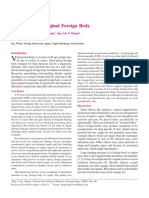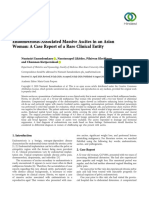Case Report
Case Report
Uploaded by
Arman MukhtarCopyright:
Available Formats
Case Report
Case Report
Uploaded by
Arman MukhtarCopyright
Available Formats
Share this document
Did you find this document useful?
Is this content inappropriate?
Copyright:
Available Formats
Case Report
Case Report
Uploaded by
Arman MukhtarCopyright:
Available Formats
CASE
REPORT
Bladder Perforation Related to Intrauterine Device
Mustafa Okan Istanbulluoglu1, Emel Ebru Ozcimen2, Bulent Ozturk1*, Ayla Uckuyu2, Tufan Cicek1, Murat Gonen1 Departments of 1Urology, and 2Gynecology and Obstetrics, Baskent University School of Medicine, Turkey.
Intrauterine devices (IUDs) are currently one of the most popular reversible contraception methods used world wide. Uterine perforation is a rarely observed complication. The bladder is one of the organs that an IUD can migrate to because of its close proximity to the uterus. There are about 70 cases in the literature of IUDs that have migrated into the bladder. The resulting bladder perforation can be complete or partial. Here, we report 2 cases, 1 of complete migration and the other of partial migration. [J Chin Med Assoc 2008;71(4):207209] Key Words: intrauterine device, urinary bladder calculi, uterine perforation
Introduction
To date, there are about 70 cases in the literature of IUDs that have migrated into the bladder. The incidence of IUD perforation ranges from 0.05/1,000 to 13/1,000. Complications like stone formation within the bladder or infection related to IUD migration to the bladder have also been reported. Such patients mostly present with urinary symptoms.110 Here, we describe 2 patients who presented with different symptoms related to the migration of IUD to the bladder.
Case Reports
Case 1
A 32-year-old, gravida 2, para 2, woman presented to our outpatient clinic with turbid urine and frequently recurring infections. Her history revealed that the complaints had been present for 2 years, and she had been going to different centers for these 2 years, where multiple antibiotics had been prescribed. She had a T-type IUD (Pregna Copper T 380 A) that had been placed by a gynecologist 6 years previously, and she had had a normal vaginal delivery 4 years later with the IUD in place. Her complaints had begun soon after delivery. Routine biochemical tests and complete blood count were normal. There were plenty of leukocytes
and pyuria in the urine. Urine culture was negative. A T-type IUD on the right side of the pelvis was observed on plain abdominal X-ray, as was an opaque stone measuring 2.5 1 cm in size (Figure 1). Ultrasound revealed a stationary stone within the bladder on the right wall. Endoscopic intervention was planned, and the stone formation within the bladder was broken up with mechanical lithotripter. It was observed that the IUD was within the bladder. Grasper forceps were used to grab the embedded portion of the IUD, and the IUD was removed as a whole unit. The urinary catheter was removed on postoperative day 1. No fistula or adhesion formation was observed.
Figure 1. Migrated intrauterine device and stone seen on pelvic plain radiography.
*Correspondence to: Dr Bulent Ozturk, Department of Urology, Baskent University School of Medicine, Hoca Cihan Mah, Saray cad. No. 1 Konya/Turkey. E-mail: bulentoz@yahoo.com Received: June 20, 2007 Accepted: February 21, 2008
J Chin Med Assoc April 2008 Vol 71 No 4
2008 Elsevier. All rights reserved.
207
M.O. Istanbulluoglu, et al
easily by pulling its string. Pelvic computed tomography showed that the spiral IUD had perforated the uterus and migrated to the bladder (Figure 3). Cystoscopy was scheduled, during which it was observed that the IUD had not penetrated the bladder mucosa, and the mucosa was intact (partial bladder perforation). Pressure of the IUD was observed during cystoscopy. A clamp was used to grab and remove the IUD via the vagina. No complications such as perforation of the uterus or bleeding developed. At the 2-month follow-up visit, the patient had no complaints and her tests were normal.
Discussion
Figure 2. Two intrauterine devices seen on pelvic plain radiography.
Figure 3. Computed tomography shows perforation of the uterus and migration of the intrauterine device into the bladder.
At the 1- and 6-month follow-up visits, the patient had no complaints and her urinalysis was normal.
Case 2
A 35-year-old, gravida 4, para 4, woman presented to the gynecology outpatient clinic with pain, dyspareunia and vaginal discharge. Her history revealed that a spiraltype IUD had been placed 14 years previously, and she had had a normal vaginal delivery 1 year after the placing of the IUD. Apart from the delivery, she had not undergone any uterine operations. She was told that her IUD had fallen, and another T-type IUD had been placed. Before placement of the T-shaped IUD, no pelvic examination had been performed. Her blood tests were normal, culture of the discharge was negative, and there were inflammatory cells on the vaginal smear. Plain X-ray of the urinary system showed 2 IUDs in the pelvis (Figure 2). Vaginal ultrasound revealed that the spiral IUD was embedded in the uterine wall, while the T-type IUD was in its normal localization. The T-type IUD was removed
IUDs are currently the most favored contraception method world wide. They can, however, lead to complications such as uterine perforation (which is rare) and pregnancy or infection (which are more frequent).2,4,5 The rare complication of perforation has been attributed to various causes in the literature, the number 1 cause being placement of the IUD by persons other than specialists. Most authors believe that IUD placement by specialists is very important in preventing perforation. However, migration of IUD placed by gynecologists, as in our case, has also been reported.2,4,10 In addition, infection and tissue damage caused by the vaginal speculum used during IUD placement can lead to adhesions and thus facilitate the perforation of the uterus.6,7 As is well known, Actinomyces infections also facilitate the perforation of the uterus. Actinomyces infection can develop frequently in the presence of an IUD.6,8 Another notable issue is that IUD migration is more frequent in women who undergo labor with their IUD in place. Due to the reduction in the size of the uterus and thinning of the uterine walls in the postpartum and lactation periods as a result of hypoestrogenemia, the uterus becomes more susceptible to perforation.4,5,10 We believe that the cause of migration of the IUDs in our 2 cases was the delivery by the patients in the presence of their IUDs. Symptoms such as chronic pelvic pain, vaginal discharge and irritation on voiding are seen when IUD has migrated into the bladder.2,3,9 While extraurinary system symptoms like chronic pelvic pain and dyspareunia were seen in our case without complete migration inside the bladder, we observed the symptoms of pyuria and irritation on voiding in the case with the complete migration of the IUD. Stones can form as a result of complete migration of the IUD. To date, approximately 70 cases of IUD migration to
208
J Chin Med Assoc April 2008 Vol 71 No 4
IUD and bladder perforation
the bladder have been reported in the literature, and about half of them resulted in stone formation, with established stone sizes varying from 1 cm to 8 cm.1,10 The foreign materials within the bladder acts as a nidus for stone formation, and infections constitute a separate predisposing factor.10 The most accurate method for imaging of lost IUD is computed tomography. Partial perforation can also be shown rather well with vaginal ultrasound.6 In addition, radiography is also useful, especially for finding the stone-forming IUDs.3,10 We were able to show very clearly in Case 2 that the S-type IUD had not completely migrated to the bladder, and that the migration was only partial. In Case 1, however, we did not need to use computed tomography since 1 arm of the IUD had petrified, and we directly planned cystoscopy. Another controversial issue is treatment for cases of lost IUD. Many authors have stated that lost IUD should be treated since it can cause pain, infection, injury of neighboring organs, intra-abdominal adhesion, and even fatal complications like sepsis or intestinal obstruction.24,9,10 Minimally invasive methods such as laparoscopy or endoscopy are frequently preferred. However, Markovitch et al advocated in an article on a series of 3 patients that not all such patients required surgical treatment.6 The situation is different for the bladder; foreign material in the urothelium always leads to the risk of stone formation, and they must be treated.3,10 We treated the case with endoscopy, which had a stone within the bladder, and were able to remove the IUD causing partial perforation through the vagina. Observation of bladder stones, particularly in women who have delivered babies in the presence of an IUD, and presence of urinary tract infections
resistant to treatment and symptoms such as dyspareunia and vaginal discharge should suggest the migration of IUD to the bladder. Endoscopic methods are efficient and safe for the treatment of such cases.
References
1. Grimaldi L, De Giorgio F, Andreotta P, DAlessio MC, Piscicelli C, Pascalia VL. Medicolegal aspects of an unusual uterine perforation with multiload-Cu 375R. Am J Forensic Med Pathol 2005;26:3656. 2. Ozcelik B, Serin IS, Basbug M, Aygen E, Ekmekcioglu O. Differential diagnosis of intra-uterine device migrating to bladder using radiographic image of calculus formation and review of literature. Eur J Obstet Gynecol Reprod Biol 2003;108:946. 3. Ozgur A, Sismanoglu A, Yazici C, Cosar E, Tezen D, Ilker Y. Intravesical stone formation on intrauterine contraceptive device. Int Urol Nephrol 2004;36:3458. 4. Hoscan MB, Kosar A, Gumustas U, Guney M. Intravesical migration of intrauterine device resulting in pregnancy. Int J Urol 2006;13:3012. 5. Guvel S, Tekin MI, Kilinc F, Peskircioglu L, Ozkardes H. Bladder stones around a migrated and missed intrauterine contraceptive device. Int J Urol 2001;8:789. 6. Markovitch O, Klein Z, Gidoni Y, Holzinger M, Beyth Y. Extrauterine mislocated IUD: is surgical removal mandatory? Contraception 2002;66:1058. 7. Harrison-Woolrych M, Ashton J. Uterine perforation on intrauterine device insertion: is the incidence higher than previously reported? Contraception 2003;67:536. 8. Phupong V, Sueblinvong T, Pruksananonda K, Taneepanichskul S, Triratanachat S. Uterine perforation with Lippes loop intrauterine device-associated actinomycosis: a case report and review of the literature. Contraception 2000;61: 34750. 9. Hick EJ, Hernandez J, Yordan R, Morey AF, Avils R, Garca CR. Bladder calculus resulting from the migration of an intrauterine contraceptive device. J Urol 2004;172:1903. 10. Atakan H, Kaplan M, Erturk E. Intravesical migration of intrauterine device resulting in stone formation. Urology 2002; 60:911.
J Chin Med Assoc April 2008 Vol 71 No 4
209
You might also like
- Bladder Calculus Resulting From The Migration of An IntrauterineDocument8 pagesBladder Calculus Resulting From The Migration of An IntrauterineFabrien Hein WillemNo ratings yet
- 2021 Article 1443-3Document5 pages2021 Article 1443-3Furkan OzsoyNo ratings yet
- Spontaneous Perforated Pyometra With An Intrauterine Device in Menopause: A Case ReportDocument2 pagesSpontaneous Perforated Pyometra With An Intrauterine Device in Menopause: A Case ReportTomy SaputraNo ratings yet
- AN INTRA-UTERINE DISPOSITIF (IUD) MIGRATEUR EN INTRARECTAL : A CASE REPORTDocument5 pagesAN INTRA-UTERINE DISPOSITIF (IUD) MIGRATEUR EN INTRARECTAL : A CASE REPORTIJAR JOURNALNo ratings yet
- A Case of Intravaginal Foreign BodyDocument3 pagesA Case of Intravaginal Foreign BodyNara SafaNo ratings yet
- Case Report: Retained Intrauterine Device (IUD) : Triple Case Report and Review of The LiteratureDocument9 pagesCase Report: Retained Intrauterine Device (IUD) : Triple Case Report and Review of The LiteratureYosie Yulanda PutraNo ratings yet
- Oup Accepted Manuscript 2020Document3 pagesOup Accepted Manuscript 2020Rizka Desti AyuniNo ratings yet
- Case Report Ghazanfar Page 130-132Document3 pagesCase Report Ghazanfar Page 130-132sohailurologistNo ratings yet
- Misplaced Copper T: A Comprehensive OverviewDocument7 pagesMisplaced Copper T: A Comprehensive OverviewIJAR JOURNALNo ratings yet
- Successful Laparoscopic Treatment of Intrauterine Device and Complication Causing Uterine RuptureDocument2 pagesSuccessful Laparoscopic Treatment of Intrauterine Device and Complication Causing Uterine Rupturepublishing groupNo ratings yet
- 1 s2.0 S2210261221003527 MainDocument4 pages1 s2.0 S2210261221003527 MainFurkan OzsoyNo ratings yet
- Uterine Perforation After Pose of IUD, The Place of Abdomen Radiography Without PreparationDocument5 pagesUterine Perforation After Pose of IUD, The Place of Abdomen Radiography Without Preparationvianchasamiera berlianaNo ratings yet
- An Unconventional Therapeutic Approach To A Migratory IUD Causing Perforation of The RectumDocument2 pagesAn Unconventional Therapeutic Approach To A Migratory IUD Causing Perforation of The Rectumvianchasamiera berlianaNo ratings yet
- Infected Urachal Cyst in An Adult A Case Report and Review of The LiteratureDocument3 pagesInfected Urachal Cyst in An Adult A Case Report and Review of The LiteratureAhmad Ulil AlbabNo ratings yet
- Jurnal Obgyn 9 YDocument7 pagesJurnal Obgyn 9 Ypinkyindah24No ratings yet
- Urological Science: Jiun-Hung Geng, Chun-Nung HuangDocument4 pagesUrological Science: Jiun-Hung Geng, Chun-Nung Huangyerich septaNo ratings yet
- 44 Danfulani EtalDocument3 pages44 Danfulani EtaleditorijmrhsNo ratings yet
- Case Report Aditya - Jurnal VancoverDocument6 pagesCase Report Aditya - Jurnal VancoverAditya AirlanggaNo ratings yet
- Hysteroscopic Management of Omentum Incarceration (Ingles)Document6 pagesHysteroscopic Management of Omentum Incarceration (Ingles)silviadmcastellanNo ratings yet
- A Rare Case of Endometriosis in Turners SyndromeDocument3 pagesA Rare Case of Endometriosis in Turners SyndromeElison J PanggaloNo ratings yet
- Extra Pelvic Endometriosis: Double Ileal and Ileo-Caecal Localization Revealed by Acute Small Bowel Obstruction, A Clinical CaseDocument9 pagesExtra Pelvic Endometriosis: Double Ileal and Ileo-Caecal Localization Revealed by Acute Small Bowel Obstruction, A Clinical CaseIJAR JOURNALNo ratings yet
- Urology Case Reports: Aideen Madden, Asadullah Aslam, Nadeem B. NusratDocument3 pagesUrology Case Reports: Aideen Madden, Asadullah Aslam, Nadeem B. NusratsoufiearyaniNo ratings yet
- Accidental File SwallowingDocument6 pagesAccidental File SwallowingShivani DubeyNo ratings yet
- 1 s2.0 S0301211514002905Document3 pages1 s2.0 S0301211514002905Rahma UlfaNo ratings yet
- Chronic Non-Puerperal Uterine Inversion Mimicking Complete Uterine ProlapsedDocument6 pagesChronic Non-Puerperal Uterine Inversion Mimicking Complete Uterine ProlapsedCentral Asian StudiesNo ratings yet
- Umbilical GranulomaDocument3 pagesUmbilical GranulomaNina KharimaNo ratings yet
- Managing Ureterocoele in A Teenage GirlDocument6 pagesManaging Ureterocoele in A Teenage GirlAnab Rehan TaseerNo ratings yet
- A Sonographic Sign of Moderate ToDocument5 pagesA Sonographic Sign of Moderate ToDivisi FER MalangNo ratings yet
- A Case of Postmenopausal Pyometra Caused by Endometrial TuberculosisDocument4 pagesA Case of Postmenopausal Pyometra Caused by Endometrial TuberculosisJimmy Oi SantosoNo ratings yet
- Bilateral Tubo-Ovarian Abscess After Cesarean Delivery: A Case Report and Literature ReviewDocument4 pagesBilateral Tubo-Ovarian Abscess After Cesarean Delivery: A Case Report and Literature ReviewIntan PermataNo ratings yet
- Cervical and Vaginal Agenesis - A Rare Case ReportDocument5 pagesCervical and Vaginal Agenesis - A Rare Case ReportEditor_IAIMNo ratings yet
- Once in A Blue Moon, Congenital Anterior Urethral DiverticulumDocument5 pagesOnce in A Blue Moon, Congenital Anterior Urethral Diverticulumma18273645thNo ratings yet
- Spontaneous Rupture of Choledochal Cyst During Pregnancy: A Case ReportDocument3 pagesSpontaneous Rupture of Choledochal Cyst During Pregnancy: A Case ReportInternational Organization of Scientific Research (IOSR)No ratings yet
- International Journal of Pharmaceutical Science Invention (IJPSI)Document3 pagesInternational Journal of Pharmaceutical Science Invention (IJPSI)inventionjournalsNo ratings yet
- Cystogram With Dumbbell Shaped Urinary Bladder in A Sliding Inguinal HerniaDocument3 pagesCystogram With Dumbbell Shaped Urinary Bladder in A Sliding Inguinal HerniaSuhesh Kumar NNo ratings yet
- Successful Management of Giant Hydrocolpos in A LiDocument3 pagesSuccessful Management of Giant Hydrocolpos in A LiVictor FernandoNo ratings yet
- Thin Anterior Uterine Wall With Incomplete UterineDocument4 pagesThin Anterior Uterine Wall With Incomplete UterinedelaNo ratings yet
- Zhang 2021Document5 pagesZhang 2021miraraspopovic020No ratings yet
- 5827 16093 1 PBDocument5 pages5827 16093 1 PBTitan LinggastiwiNo ratings yet
- Observational Study of New Treatment Proposal For Severe Intrauterine AdhesionDocument14 pagesObservational Study of New Treatment Proposal For Severe Intrauterine AdhesionOpenaccess Research paperNo ratings yet
- Ovarian TorsionDocument4 pagesOvarian TorsionRiko KuswaraNo ratings yet
- Girija BS, Sudha TR: AbstractDocument4 pagesGirija BS, Sudha TR: AbstractALfuNo ratings yet
- Fallopian Tube HerniationDocument4 pagesFallopian Tube HerniationAliyaNo ratings yet
- Endoscopic Removal of Intrauterine Contraceptive device from descending colonDocument4 pagesEndoscopic Removal of Intrauterine Contraceptive device from descending colonshabbirNo ratings yet
- Case Report EndometriosisDocument4 pagesCase Report EndometriosischristinejoanNo ratings yet
- Uterine rupture due to pyometra and imperforate hymen in a 7-year-old girl: A case reportDocument4 pagesUterine rupture due to pyometra and imperforate hymen in a 7-year-old girl: A case reportUsama AzizNo ratings yet
- Patent Urachus With Patent Vitellointestinal Duct A Rare CaseDocument2 pagesPatent Urachus With Patent Vitellointestinal Duct A Rare CaseAhmad Ulil AlbabNo ratings yet
- Super Main Am 2019Document2 pagesSuper Main Am 2019houssein.hajj.mdNo ratings yet
- Laparoscopic Removal of Translocated Retroperitoneal IUD: K.K. Roy, N. Banerjee, A. SinhaDocument3 pagesLaparoscopic Removal of Translocated Retroperitoneal IUD: K.K. Roy, N. Banerjee, A. SinhaIqra AnugerahNo ratings yet
- Superior Vesical Fissure: Variant Classical Bladder ExstrophyDocument3 pagesSuperior Vesical Fissure: Variant Classical Bladder ExstrophyChindia BungaNo ratings yet
- Cervical Tear: A Rare Route of Delivery: Case Report: Bhaktii Kohli and Madhu NagpalDocument2 pagesCervical Tear: A Rare Route of Delivery: Case Report: Bhaktii Kohli and Madhu NagpalAisyah MajidNo ratings yet
- Primary Ovarian Abscess in Pregnancy: Case ReportDocument3 pagesPrimary Ovarian Abscess in Pregnancy: Case ReportVinnyRevinaAdrianiNo ratings yet
- Pólipo Vesical 2022Document4 pagesPólipo Vesical 2022ntytapNo ratings yet
- Gartner Duct Cyst Simplified Treatment ApproachDocument3 pagesGartner Duct Cyst Simplified Treatment ApproachTiara AnggrainiNo ratings yet
- Anterior Cervical Wall Rupture As A Result of Induced AbortionDocument4 pagesAnterior Cervical Wall Rupture As A Result of Induced AbortionnawriirwanNo ratings yet
- Paraurethral Cyst: A Case Report: Central European Journal ofDocument3 pagesParaurethral Cyst: A Case Report: Central European Journal ofEltohn JohnNo ratings yet
- Laparoscopic Management of Cervical-Isthmic Pregnancy: A Proposal MethodDocument4 pagesLaparoscopic Management of Cervical-Isthmic Pregnancy: A Proposal MethodDinorah MarcelaNo ratings yet
- Ureteral Stenosis After Uterine Suspension Using TVM Transvaginal MeshDocument3 pagesUreteral Stenosis After Uterine Suspension Using TVM Transvaginal MeshWorld Journal of Clinical SurgeryNo ratings yet
- Interpretation of Urodynamic Studies: A Case Study-Based GuideFrom EverandInterpretation of Urodynamic Studies: A Case Study-Based GuideNo ratings yet
- 5 WormsDocument5 pages5 Wormsreaj.jumsaliNo ratings yet
- 1-Introduction MDDocument38 pages1-Introduction MDRasheena RasheeqNo ratings yet
- Eye Docs Pathology & MicrobiologyDocument36 pagesEye Docs Pathology & MicrobiologyMuhammed AbdulmajeedNo ratings yet
- Diagnosis of Abd TBDocument3 pagesDiagnosis of Abd TBIrtif PandoraNo ratings yet
- List of BacteriaDocument3 pagesList of BacteriaSol T. ParedesNo ratings yet
- ImpetigoDocument3 pagesImpetigoKhimiana SalazarNo ratings yet
- 15 To 45 CLAT 2021, GK - Questions PDFDocument192 pages15 To 45 CLAT 2021, GK - Questions PDFAnjali GuptaNo ratings yet
- Pinyin Dictionary M To e A5c1Document237 pagesPinyin Dictionary M To e A5c1Zianaly JeffryNo ratings yet
- Integ CD TipsDocument2 pagesInteg CD TipsNia KayeNo ratings yet
- 2015 HBV EQA Result FormDocument3 pages2015 HBV EQA Result FormTiny Coffee HouseNo ratings yet
- Bee Stings: The British Beekeepers AssociationDocument3 pagesBee Stings: The British Beekeepers AssociationantonioforteseNo ratings yet
- Grapefruit in SomaliaDocument12 pagesGrapefruit in SomaliaMohamed Haji Maywo100% (1)
- Turbo Jet Manual English Current-1Document21 pagesTurbo Jet Manual English Current-1irrygNo ratings yet
- Rubella VirusDocument16 pagesRubella VirusPeter NazeerNo ratings yet
- Fungal Infections of The Skin: Dr. M. DissanayakeDocument52 pagesFungal Infections of The Skin: Dr. M. Dissanayakev_vijayakanth7656100% (1)
- Bovine Disease Diagnostic ManualDocument40 pagesBovine Disease Diagnostic ManualYaserAbbasi100% (1)
- Salmonella 1Document3 pagesSalmonella 1Kristiara UnoNo ratings yet
- Immunization - Dr. SarahDocument14 pagesImmunization - Dr. Sarahf6bk6xnppyNo ratings yet
- Candida Albicans ADocument3 pagesCandida Albicans Anitkol100% (1)
- Infectious Disease NotesDocument43 pagesInfectious Disease NotessaguNo ratings yet
- Microbiology and Immunology Pokhara University Syllabus NOCDocument2 pagesMicrobiology and Immunology Pokhara University Syllabus NOCDinesh SubediNo ratings yet
- SLMA Guidelines and Information On Vaccines 2020 7th-EditionDocument400 pagesSLMA Guidelines and Information On Vaccines 2020 7th-EditionRajithaHirangaNo ratings yet
- Chronic SinusitisDocument19 pagesChronic SinusitisMunawwar AwaNo ratings yet
- PenicillinDocument14 pagesPenicillinVeena PatilNo ratings yet
- Stages of InfectionDocument4 pagesStages of InfectionMark Gabriel DomingoNo ratings yet
- Covid-19 Virus RT-PCR (Open System) Qualitative - Centre VisitDocument2 pagesCovid-19 Virus RT-PCR (Open System) Qualitative - Centre VisitChinish KalraNo ratings yet
- Toxoigm ArcDocument6 pagesToxoigm Arctesteste testeNo ratings yet
- MeasDocument14 pagesMeasKareem AlhozeeliNo ratings yet
- Barrier NursingDocument5 pagesBarrier NursingShiny Preethi100% (2)
- Teaching Plan On DengueDocument4 pagesTeaching Plan On DengueGia P. de VeyraNo ratings yet

























































































